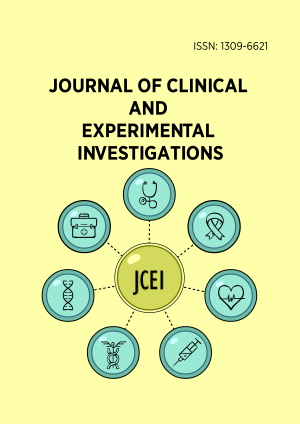Volume 4, Issue 2, June 2013
Research Article
Evaluation of epidemiological data of 541 patients with brucellosis in Siirt, a city in south-eastern Anatolia
J Clin Exp Invest, Volume 4, Issue 2, June 2013, 136-140
https://doi.org/10.5799/ahinjs.01.2013.02.0253Research Article
Evaluation of fetal ventriculomegaly
J Clin Exp Invest, Volume 4, Issue 2, June 2013, 141-147
https://doi.org/10.5799/ahinjs.01.2013.02.0254Research Article
Data evaluation of Ankara Numune Training and Education Hospital immunofixation electrophoresis
J Clin Exp Invest, Volume 4, Issue 2, June 2013, 148-152
https://doi.org/10.5799/ahinjs.01.2013.02.0255Research Article
Ultrasound evaluation of metabolic syndrome patients with hepatosteatosis
J Clin Exp Invest, Volume 4, Issue 2, June 2013, 153-158
https://doi.org/10.5799/ahinjs.01.2013.02.0256Research Article
A retrospective investigation of the patient-controlled analgesia methods applied for postoperative pain management
J Clin Exp Invest, Volume 4, Issue 2, June 2013, 159-165
https://doi.org/10.5799/ahinjs.01.2013.02.0257Research Article
Frequency of HBsAg, anti-HCV, and anti-HIV in pregnant women and/or patients with gynecologic diseases in a tertiary hospital
J Clin Exp Invest, Volume 4, Issue 2, June 2013, 166-170
https://doi.org/10.5799/ahinjs.01.2013.02.0258Research Article
Halo Vest treatment of upper cervical vertebral fracture
J Clin Exp Invest, Volume 4, Issue 2, June 2013, 171-174
https://doi.org/10.5799/ahinjs.01.2013.02.0259Research Article
Primary intra-abdominal hydatid cyst cases with extra-hepatic localization
J Clin Exp Invest, Volume 4, Issue 2, June 2013, 175-179
https://doi.org/10.5799/ahinjs.01.2013.02.0260Research Article
Clinical characteristics, background illnesses and in-hospital mortality rates of patients who has a temporary pacemaker implanted
J Clin Exp Invest, Volume 4, Issue 2, June 2013, 180-183
https://doi.org/10.5799/ahinjs.01.2013.02.0261Research Article
Comparison between fractional flow reserve and visual assessment by multiple observers in patients with moderate coronary artery lesions
J Clin Exp Invest, Volume 4, Issue 2, June 2013, 184-188
https://doi.org/10.5799/ahinjs.01.2013.02.0262Research Article
Association of the sleep quality with pain, radiological damage, functional status and depressive symptoms in patients with knee osteoarthritis
J Clin Exp Invest, Volume 4, Issue 2, June 2013, 189-194
https://doi.org/10.5799/ahinjs.01.2013.02.0263Research Article
Tear levels of macrophage migration inhibitory factor in vernal keratoconjunctivitis
J Clin Exp Invest, Volume 4, Issue 2, June 2013, 195-198
https://doi.org/10.5799/ahinjs.01.2013.02.0264Research Article
Magnetic resonance imaging findings of sacroiliitis in patients with psoriasis
J Clin Exp Invest, Volume 4, Issue 2, June 2013, 199-203
https://doi.org/10.5799/ahinjs.01.2013.02.0265Research Article
Assessment of the sleep parameters in patients with obstructive sleep apnea syndrome with a history of traffic accident
J Clin Exp Invest, Volume 4, Issue 2, June 2013, 204-207
https://doi.org/10.5799/ahinjs.01.2013.02.0266Research Article
Colorectal cancers: 12 year-results of a single center
J Clin Exp Invest, Volume 4, Issue 2, June 2013, 208-212
https://doi.org/10.5799/ahinjs.01.2013.02.0267Research Article
Comparison of acute phase response during attack and attack-free period in children with Familial Mediterranean Fever
J Clin Exp Invest, Volume 4, Issue 2, June 2013, 213-218
https://doi.org/10.5799/ahinjs.01.2013.02.0268Brief Report
Phantom tumor of the lung in a patient with preserved left ventricular systolic function
J Clin Exp Invest, Volume 4, Issue 2, June 2013, 242-243
https://doi.org/10.5799/ahinjs.01.2013.02.0276Case Report
Fibrous dysplasia originating from the middle ear
J Clin Exp Invest, Volume 4, Issue 2, June 2013, 219-220
https://doi.org/10.5799/ahinjs.01.2013.02.0269Case Report
Osteoma located in the external ear canal
J Clin Exp Invest, Volume 4, Issue 2, June 2013, 221-222
https://doi.org/10.5799/ahinjs.01.2013.02.0270Case Report
Acute epidural hematoma manifesting with monoplegia in a child: Case report
J Clin Exp Invest, Volume 4, Issue 2, June 2013, 223-225
https://doi.org/10.5799/ahinjs.01.2013.02.0271Case Report
A case of Plasmodium vivax malaria with respiratory failure
J Clin Exp Invest, Volume 4, Issue 2, June 2013, 226-228
https://doi.org/10.5799/ahinjs.01.2013.02.0272Case Report
Anticoagulant-induced hemopericardium with tamponade: A case report and review of the literature
J Clin Exp Invest, Volume 4, Issue 2, June 2013, 229-233
https://doi.org/10.5799/ahinjs.01.2013.02.0273Case Report
Anesthetic management in an appendix tumor patient undergoing hyperthermic chemotherapy
J Clin Exp Invest, Volume 4, Issue 2, June 2013, 234-237
https://doi.org/10.5799/ahinjs.01.2013.02.0274Case Report
Anesthetic management in a pediatric patient with Noonan syndrome, hypopituitarism and hypothyroidism: A case report
J Clin Exp Invest, Volume 4, Issue 2, June 2013, 238-241
https://doi.org/10.5799/ahinjs.01.2013.02.02275Review
Magnesium: Effect on ocular health as a calcium channel antagonist
J Clin Exp Invest, Volume 4, Issue 2, June 2013, 244-251
https://doi.org/10.5799/ahinjs.01.2013.02.0277Review
Lung diseases due to non-tuberculosis mycobacteria
J Clin Exp Invest, Volume 4, Issue 2, June 2013, 252-257
https://doi.org/10.5799/ahinjs.01.2013.02.0278Review
The application of laboratory tests in pediatric rheumatology practice
J Clin Exp Invest, Volume 4, Issue 2, June 2013, 258-261
https://doi.org/10.5799/ahinjs.01.2013.02.0279Letter to Editor
Leukemoid reaction in a patient with acute lymphoblastic leukemia following the second chemotherapy
J Clin Exp Invest, Volume 4, Issue 2, June 2013, 262-263
https://doi.org/10.5799/ahinjs.01.2013.02.0280
